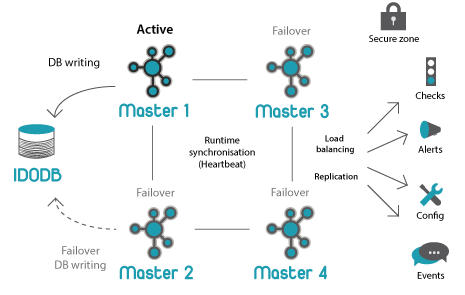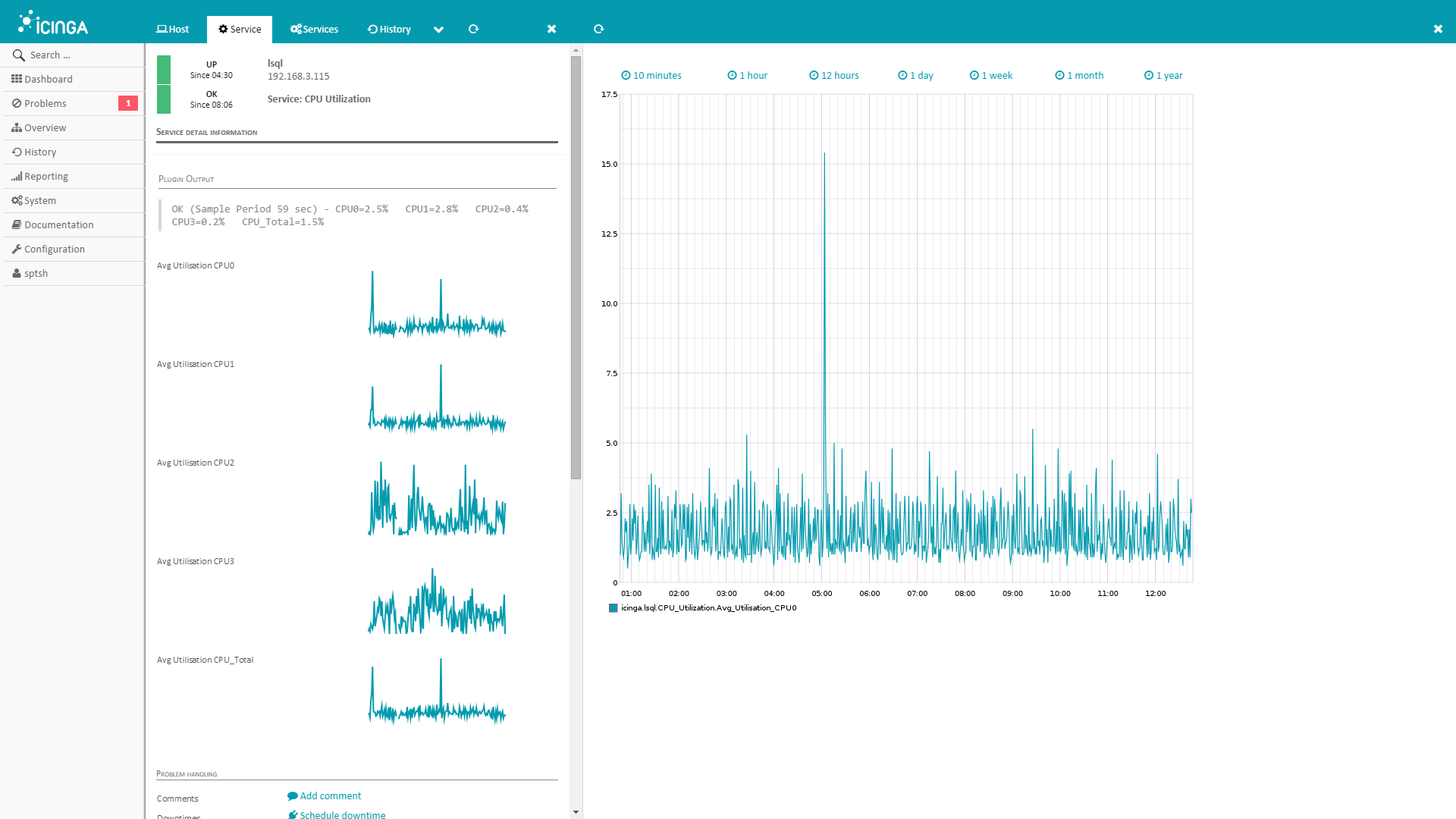Icinga2 and agentless monitoring of Windows servers using WMI

Today, not everyone is satisfied with the IT infrastructure monitoring system used, and for some it is simply not available. Many of them have obvious problems with usability, configuration complexity and low productivity. That is why, I suggest to look at the new fork of Nagios - Icinga 2, which is ready to please us with a modular architecture, user-friendly web-interface, report generation and excellent speed!
About the system itself
At first glance, Icinga 2 immediately has a pleasant-looking web interface, with a large number of different representations of hosts and services (various lists, calendar, grid), but these are not all the advantages of this monitoring system.
The configuration style is different from its previous version, it has an object-oriented format (similar to Puppet) and allows you to define dependencies and host / service parent / child relationships for hosts. The dependencies in Icinga 2 are direct, they can be defined as host-host, service-service, or mixed host-service and service-host. Volume configurations can be minimized by applying templates to objects. During the operation of the system, you will understand how convenient it is. Personally, I have always been dissatisfied with the lack of the possibility of setting up monitoring via the web interface, in view of the complexity of the configuration files, but in this case, I am happy about it.
')
Icinga2 is built with a focus on performance, has a multi-threaded design and can perform thousands of checks per second. The system itself can be installed as a high-availability cluster or as a single instance.

Also, highly available clusters can be combined into a distributed installation, in which operations are spread over several sites. Replication can be isolated for its implementation only between the primary and secondary zones. Secondary zones can be either full-fledged copies of Icinga 2, with a local IDO database and user interface, or simple instances that perform checks.

Icinga 2 comes with several engines and almost any addon can be easily integrated, in particular the Perfdata module is included initially. For example, Icinga 2 offers the integration of popular productivity graphing tools such as PNP4Nagios, inGraph, and Graphite.
Customization
There is no point in considering the installation of Icinga 2 itself, since it is simple and very clearly described in the documentation , in my case it is installed on CentOS 7 and PostgreSQL. First, do not forget to install EPEL:
yum install epel-release Also, when it is configured via the web interface, it is necessary to use two bases, and not one (otherwise, an error in creating a user will occur).
For full monitoring using WMI, we need several plugins and a prepared Windows Server.
First, install wmic and Scheck WMI Plus using the step-by-step guide located here .
Next, you need to prepare Windows Server for processing incoming WMI requests, to do this, enter in the command line:
winrm quickconfig The user on whose behalf we will connect to the server must be in the group of local administrators, and also do not forget about the firewall.
For verification, we run two times:
/opt/nagios/bin/plugins/check_wmi_plus.pl -m checkcpu -H HOST -u USER -p PASS We now turn to the configuration itself Icinga 2.
The main configuration files are located in /etc/icinga2/conf.d/
Prepare a group for our Windows servers by adding the following to the groups.conf file:
object HostGroup "windows-servers" { display_name = "Windows Servers" assign where host.vars.os == "Windows" } All hosts in configurations of which the element is present will fall into this group:
host.vars.os = "Windows" We describe the use of the Check WMI Plus plugin. To do this, open commands.conf and add the following content:
object CheckCommand "check_wmi" { import "plugin-check-command" command = [ WmiPluginDir + "/check_wmi_plus.pl" ] arguments = { "--inidir" = "$wmi_inidir$" "-H" = "$host.name$" "-A" = "$wmi_authfile_path$" "-m" = "$check_mode$" "-s" = "$wmi_submode$" "-a" = "$wmi_arg1$" "-o" = "$wmi_arg2$" "-3" = "$wmi_arg3$" "-4" = "$wmi_arg4$" "-y" = "$wmi_delay$" "-w" = "$wmi_warn$" "-c" = "$wmi_crit$" "--nodatamode" = { set_if = "$wmi_nodatamode$" } } vars.wmi_authfile_path = "/etc/icinga2/wmi.auth" vars.wmi_inidir = "/opt/nagios/bin/plugins/check_wmi_plus.d" vars.wmi_nodatamode = false } Create an authorization file for the plugin ( /etc/icinga2/wmi.auth ) with the following contents:
username=user@domain.domain password=pass domain= Set the value to a constant in the constants.conf file:
const WmiPluginDir = "/opt/nagios/bin/plugins" Create a template for our services in templates.conf :
template Service "wmi-service" { import "generic-service" check_command = "check_wmi" check_interval = 1m retry_interval = 1m } Here you can set the desired inspection interval.
On the plugin page there are examples of configuration services for Nagios, we just need to edit them a little.
For example, add the following service to the services.conf file:
apply Service "MSSQL: General Statistics" { import "wmi-service" vars.check_mode = "checksql" vars.wmi_submode = "general" vars.wmi_arg1 = host.vars.sql assign where host.vars.sql ignore where host.vars.disable_wmi } Add a host to the hosts.conf file:
object Host "sql" { address = "XXXX" check_command = "hostalive" vars.os = "Windows" vars.sql = "MSSQL***_MSSQL***" } # *** - SQL In this example, the “MSSQL: General Statistics” service will be applied to a host that has the variable vars.sql specified in the configuration and its value will be used in the WMI query as an argument.
It remains only to make a graphical representation of the collected data, for this we need Graphite and its web module for our Icinga 2.
Install Graphite:
yum install graphite-web graphite-web-selinux /usr/bin/graphite-manage syncdb --noinput /usr/bin/graphite-build-index /usr/bin/chown -R apache:apache /var/lib/graphite-web yum install python-carbon python-whisper systemctl enable carbon-cache systemctl start carbon-cache systemctl restart httpd We edit the apache settings for vhost at our discretion.
Enable the use of Graphite in Icinga 2:
icinga2 feature enable graphite systemctl restart icinga2 Download the web module from here . Unpack the folder / usr / share / icingaweb2 / modules and rename the module root folder to graphite (otherwise an error will occur). Create the /etc/icingaweb2/modules/graphite/config.ini configuration file with the following contents:
[graphite] metric_prefix = icinga base_url = http://172.18.200.15/render? Now it remains to enable the web module (Configuration -> Modules -> graphite -> enable) and enjoy the result:


PS: In the next part we will look at monitoring network equipment
Source: https://habr.com/ru/post/262115/
All Articles